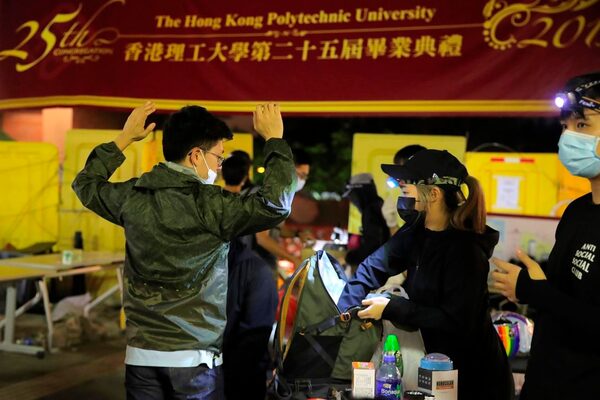
Protestors search a man's backpack at the Hong Kong Polytechnic University in Hong Kong, Friday, Nov. 15, 2019. Many of the protesters who had barricaded themselves in a Hong Kong university this week began to leave Friday after temporarily clearing a road they had blocked and demanding that the government commit to going ahead with local elections on Nov. 24.The Associated Press
Rebellious students and anti-government protesters abandoned their occupation of at least one major Hong Kong university after a near weeklong siege by police, but some other schools remained under control of demonstrators on Saturday.
Traffic disruptions continued to plague parts of the city, and schools and universities remain closed in the city of 7.5 million people.
Now in their sixth month, the anti-government protests have grown increasingly violent even as they have shrunk in size, often causing chaos in the streets.
The protests were sparked by a government decision to submit legislation that would have allowed the extradition of criminal suspects to the mainland. Activists saw it as an erosion of Hong Kong’s autonomy under the “one country, two systems” formula implemented in 1997, when Britain returned the territory to China.
The bill has been withdrawn, but the protests have expanded into a wider resistance movement against what is perceived as the growing control of Hong Kong by Communist China, along with calls for more autonomy for the territory.
Universities have become the focus of the protests in the past week and the main battleground between pro-democracy activists and the police.
Police retook control of suburban Chinese University of Hong Kong after students and protesters left.
Authorities said that all lanes of Tolo Highway, which the Chinese University protesters had blocked, were reopened around midday.
Police and protesters fought intense running battles at the Chinese University campus Tuesday, which had been transformed into a fortress by hundreds of protesters.
Except for the Polytechnic University in Kowloon, most of the remaining nine major universities in the city were for the most part no longer occupied, except by a handful of protesters. A hardcore group, numbering about 100, retained their grip on Polytechnic.
Students there have amassed a huge arsenal that includes hundreds of Molotov cocktails, rocks and paving stones. The campus is adjacent to a major road tunnel under the water to Hong Kong island that has been closed for days after protesters set toll booths on fire.
Service remained partially suspended on at least three of Hong Kong’s 12 rail lines because of damage to stations and other facilities, and many of the city’s buses were not running.
The presidents of nine universities issued a joint statement late Friday calling on the government to resolve the political deadlock and restore safety and public order.
“No political viewpoint gives a license to damage property, employ physical threats, or use violence against individuals,” the statement read in part. “It is regrettable that societal disagreement has led to university campuses becoming major political battlefields, and that the government response has so far not been effective.”
Many universities have cancelled classes for the rest of the year and hundreds of foreign students, and from mainland China, had left or were leaving Hong Kong. Some protesters targeted mainland students, while foreign students were asked to leave by their universities or governments.
Hong Kong media reported Saturday that at least 300 Dutch exchange students were asked by their home universities to return home because of the violence.
This content appears as provided to The Globe by the originating wire service. It has not been edited by Globe staff.